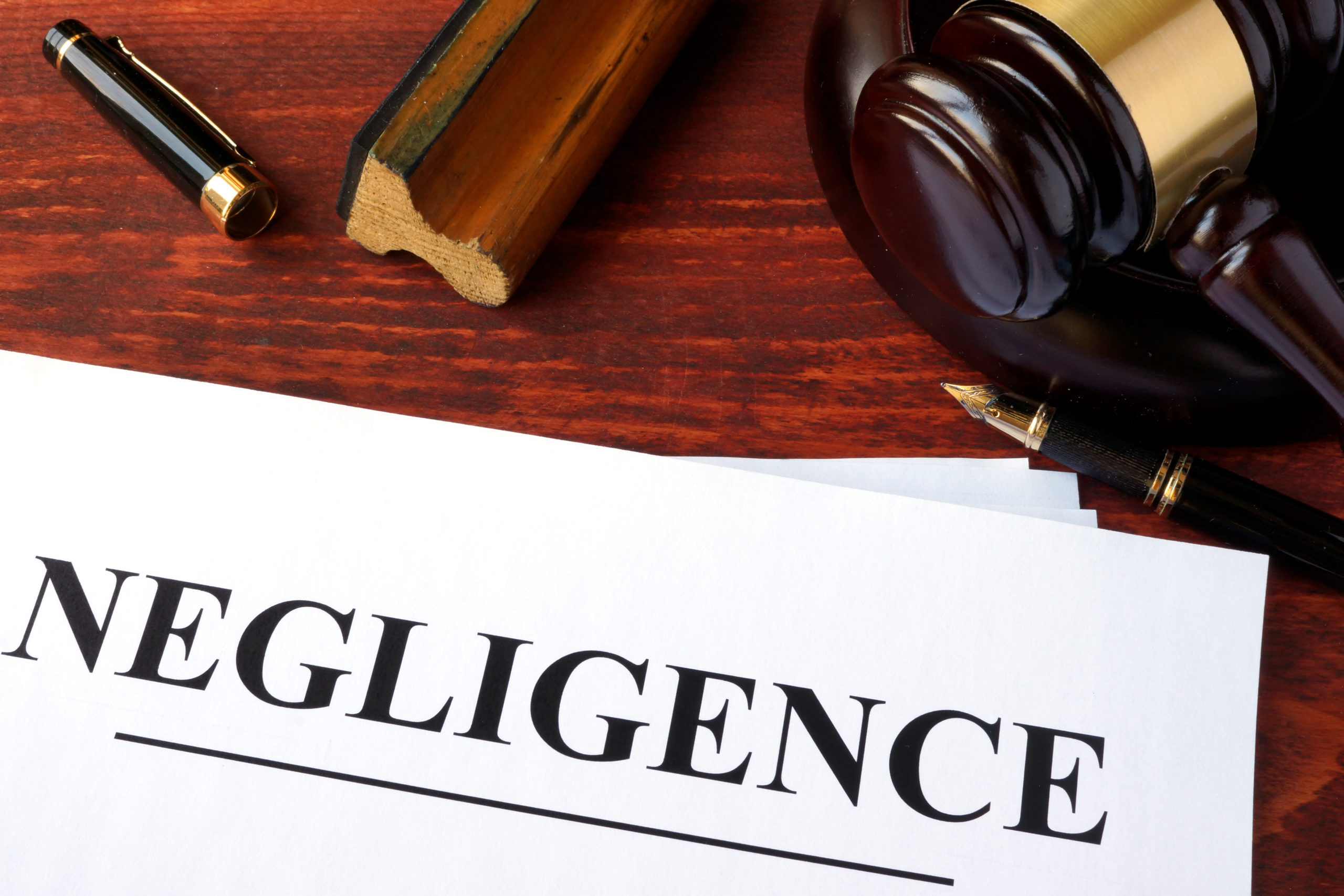One of the most common types of personal injury lawsuits in California involves a claim of negligence. The term negligence is generally defined as a person or company’s actions that caused damages or failure to take reasonable precautions to prevent others from suffering damages. Additionally, negligence occurs when a person’s actions or inaction fall below a reasonable standard of care. In law, a reasonable standard of care refers to the idea of what an ordinary or reasonable person would have done in a similar situation. Under California law, there are four legal principles of negligence required for a claim include duty of care, breach of duty of care, causation, and damages. Generally, when a person acts in a careless way that causes injury to another person, under the legal principles of negligence, that careless person can be legally responsible for causing any harm.
Elements of Negligence
Proving that someone else is responsible for your losses typically means showing that the other person acted negligently. Unfortunately, suffering an injury does not automatically mean you’re entitled to monetary compensation. To receive compensation in a personal injury case, victims of negligence will have to prove that all 4 elements of negligence resulted in damage.
- Duty: The existence of a legal duty that was owed to the plaintiff by the defendant
- Breach: Breach of duty committed by the defendant
- Cause: Evidence that breach of duty by the defendant caused damages
- Harm: Actual damages suffered by the plaintiff
How To Prove Negligence
To prove a claim for negligence, victims must prove the following:
Establishing Duty of Care
The first element that needs to be established is to determine whether the defendant owes the plaintiff a duty of care. In most cases, this duty is to behave in a similar manner as a reasonable person would in a similar situation. For example, a person who drives a car has a duty to act reasonably while driving by following all safety and traffic laws.
In some cases, the relationship between a plaintiff and defendant may establish a certain duty. For example, doctors have a duty to provide a certain standard of care to their patients. The legal duty is established when the doctor agrees to treat a patient who has requested their services.
What is Reasonable Care?
There are certain situations where a person owes another person the legal duty to act with reasonable care.
In the example of the relationship between a physician and a patient, the physician is required to provide the patient with reasonable care. When determining what the duty requires, a physician should consider whether their level of care is equivalent to the level of care that a reasonable physician would provide under similar circumstances. Keep in mind that reasonable care is not defined as the level of care any person would provide; it is defined as the level of care a reasonably careful person would provide. Many times, this is the most challenging and contentious issue at court– to determine whether a defendant acted reasonably and with reasonable care.
Determining Breach of Duty
The second element of negligence is to determine whether a duty has been breached. When determining whether a defendant has breached his or her duty of care, the court will generally use the Hand Formula or otherwise called the BPL formula. The BPL formula was created by Judge Learned Hand and describes the process to help determine whether a legal duty of care has been breached.
Below is the BPL formula:
B < PL
- B = the burden (cost) of taking precautions
- P = the probability of loss
- L = the gravity of loss
If the burden of taking precautions (B) is less than the product of the probability of loss (P) multiplied by the gravity of loss (L) of a resulting injury, then the person with the burden of taking precautions will have some level of liability.
Essentially, a breach of duty exists if a defendant did or did not do something that an average person would do under similar circumstances. In court, a jury might find a defendant negligent if an average person:
- Had the same knowledge as the defendant at the time
- Would have known that his or her behavior or actions might cause harm or injury to someone else
- Would have acted differently from how the defendant acted in that situation
For example: A dog owner knows that their dog does not interact with children in a safe manner but decides to bring their dog to a youth baseball game. At the game, the aggressive dog bites a child. In this scenario, the dog owner has breached a duty.
Determining Whether There Was a Duty to Act That Caused Injury
The third element of negligence is to determine whether there was a duty to act that caused damages. Generally, if a defendant had a duty to act and didn’t act, it would result in a breach. If the breach caused an injury, then the defendant’s actions would be considered misfeasance. There are several ways to determine whether a defendant had a duty to act including but not limited to the following:
- Creating risk: The defendant created risk in a situation and as a result, harmed the plaintiff
- Volunteering: The defendant volunteered to protect a plaintiff from harm
- Knowledge: The defendant knew or should have known that his or her actions will harm the plaintiff
- Business or voluntary relationship: When a relationship exists between 2 parties that establishes a duty of care like between a doctor and patient or hotel owner and guest.
California uses two types of causation for personal injury cases: cause in fact (actual cause) and proximate (or legal) cause.
Cause In Fact
Causation is a key element of a personal injury case. When determining negligence, causation (cause in fact) requires a victim to show that the defendant’s breach of duty was the cause of his or her injury and losses. Cause in fact is also referred to as actual cause since the cause is relatively straightforward – it’s what actually caused the victim’s losses or injuries.
However, whether a defendant could have anticipated that his or her actions might have caused an injury must also be considered. If a defendant’s actions that caused a victim’s injury could not have been expected or foreseen, then it’s likely that the defendant will not be found liable.
For example: A driver fails to stop at a stop sign and hits a pedestrian. As a result, the pedestrian gets severely injured and suffered a broken leg. In this scenario, if the driver would have stopped as he was supposed to, the pedestrian would not have been injured. The driver’s failure to exercise reasonable care while driving can be reasonably related to the victim’s severe injuries.
Proximate Cause
In a personal injury case, proximate cause refers to an event that is sufficiently related to an injury that the courts feel to be the cause of that injury. Proximate cause is also referred to as legal cause and determines liability. The most common test of proximate cause in California is foreseeability.
This determines if it is reasonable to predict that the injuries would result from a certain action.
For example: A reckless driver going over the speed limit fails to stop at a stop sign causing another car at the intersection to swerve into a pedestrian. In this instance, the reckless driver who failed to stop would be the proximate cause of the injuries suffered by the pedestrian since they were responsible for the actions of the driver that had to swerve to miss a side impact collision.
Contributory vs Comparative Negligence
Contributory negligence is a rule that prevents a plaintiff from collecting damages if their own negligence played a part in causing their own injury. Under this rule, even if the plaintiff is found to be 1% negligent, then they will not be entitled to recover any damages. Only a few states recognize contributory negligence including Alabama, Maryland, North Carolina, Virginia, and Washington D.C.
Most states, including California, use the comparative negligence system. With comparative negligence, the amount of damages will be reduced based on the proportion of the plaintiff’s own negligence that contributed to the cause of the injury.
For example, if the judge assigns 75% fault to the defendant and 25% to the plaintiff, the plaintiff may only be able to recover 75% of the damages – instead of the full 100%.
Since California uses a comparative negligence system, victims who are partially negligent may still be entitled to receive monetary compensation for their injuries. Our lawyers handle various types of personal injury cases that involve comparative negligence including car accidents, truck accidents, motorcycle accidents, and other vehicle accidents. If you were involved in an accident, contact our California personal injury law firm to learn more about how comparative negligence might impact your case.
Determining if There Was an Injury or Damages
The final element of negligence is damages. Since the plaintiff suffered a loss or injury that a reasonable person in a similar circumstance could have expected or foreseen, monetary compensation might be the only form of relief for his or her injuries. This element requires a plaintiff to prove how he or she suffered because of the accident. For example, a plaintiff might have suffered from a physical injury such as a broken arm. In this situation, the plaintiff must present evidence for medical treatment such as hospital records, medical bills, the prognosis of the injury, chiropractor records, physical therapy, and out-of-pocket expenses including medication and travel expenses. Generally, to determine if there was an injury, the injury must meet one of two requirements:
- Bodily harm
- Property damage (can be real property or personal property)
A pure economic loss will not generally meet the injury requirement. However, there are certain circumstances where emotional distress or harm may meet the bodily harm requirement – regardless of if there was physical harm.
In a personal injury case, victims could be entitled to economic and non-economic damages including lost wages, medical costs, and pain and suffering. In special cases, punitive damages may also be awarded.
Unfortunately, nominal damage is typically not actionable. Nominal damages are awarded when the plaintiff is legally right but hasn’t suffered substantial losses. And since the plaintiff doesn’t have an established need for compensation, the amount awarded in these cases is generally very small.
Receiving Compensation After Proving Negligence
When filing a personal injury claim for negligence, you may want to know the amount of monetary compensation you can expect to receive. Since each personal injury case is unique, the compensation each victim receives after proving negligence will also vary depending on the factors in each case.
However, elements that can determine the amount of compensation you might be entitled to include:
- The severity and type of injuries you sustained from the accident.
- The type of negligence that led to your injuries.
- The long-term and short-term effects that your injuries have on your life and lifestyle.
- The loss of income because of your injuries.
If you were injured due to someone else’s negligence, contact our experienced Los Angeles personal injury attorneys for help. Our attorneys can help evaluate your claim and identify all sources of compensation you might be entitled to receive.
Examples of Negligence Claims
Negligence refers to several types of personal injury cases. Some common examples of negligence claims include:
- Automobile accidents
- Premises liability
- Dog bites
- Medical malpractice
- Workplace accidents
- Defective products
- Elder neglect or abuse
- Slip and fall
- Wrongful death
Our personal injury law firm can help you determine if your situation has the elements required to prove negligence in a personal injury claim.
After doing so, our legal team can start the process of gathering evidence to present the strongest case in your favor.
Contact Mesriani Law Group If You Have Been a Victim of Negligence
If you have been injured or hurt due to someone else’s negligence, you may be entitled to damages for your losses. The negligence lawyers at Mesriani Law Group have over 20 years of experience handling these types of cases and have recovered maximum compensation for our clients. Contact our law firm today for your free consultation and see how a negligence lawyer can help obtain the justice you deserve.
Elements of Negligence FAQ
What are the 4 types of negligence?
The four types of negligence are gross negligence, contributory negligence, comparative negligence, and vicarious negligence. Gross negligence is the most serious type of negligence. Cases include reckless behavior that a reasonable person wouldn’t commit. Contributory negligence happens when a person isn’t 100% at fault but is negligent in some way. Under this rule, even if the plaintiff is found to be 1% negligent, then they will not be entitled to recover any damages. With comparative negligence, both parties are partially responsible for an accident and the amount of damages will be reduced based on the proportion of the plaintiff’s own negligence that contributed to the cause of the injury. Vicarious negligence is when a person is indirectly responsible for an accident or injury.
What are the four elements of neglect?
The four elements of neglect include duty of care, breach of duty of care, causation, and damages. The first element that needs to be established is to determine whether the defendant owes the plaintiff a duty of care. In most cases, this duty is to behave in a similar manner as a reasonable person would in a similar situation. The second element of negligence is to determine whether a duty has been breached and the court will generally use the Hand Formula or BPL formula. The third element of negligence is to determine whether there was a duty to act. Generally, if a defendant had a duty to act and didn’t act, it would result in a breach. The final element of negligence is damages. Since the plaintiff suffered a loss or injury that a reasonable person in a similar circumstance could have expected or foreseen, monetary compensation might be the only form of relief for his or her injuries.
How do you define negligence?
Negligence is defined as the failure to exercise the care toward another person which a prudent person or reasonable person would do in the same or similar circumstance. The important part of this definition to keep in mind is the part that compares the action to that of a reasonable person. For example, a reasonable person would not drive drunk because they know they could hurt or kill someone on the road.
What is gross negligence?
Gross negligence is the extreme recklessness or indifference for the safety of others. Gross negligence is not just simply a failure to act or carelessness. Rather, it’s deliberate behavior done with extreme disregard for the safety and health of other people. It’s behavior that is likely to cause foreseeable injury or harm. Common examples of gross negligence include a driver speeding in a school zone where the speed limit is typically between 15 mph and 25 mph; a doctor prescribing a patient medication that their medical records clearly state they’re allergic to; and a nursing home staff failing to provide residents with food or water for several days.








